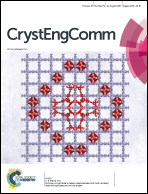Interaction between aromatic rings as organizing tools and semi-coordination in Cu(ii) compounds†
Abstract
In this paper, we present the use of the interaction between aromatic rings—usually called π–π interaction—as the main tool in the organization of coordination complexes in a crystal. To do so, we selected coordination compounds with aromatic rings pointing outside the molecules to favor their self-assembly through these interactions. Here, we report the molecular and crystal structures of three Cu(II) complexes: [Cu2(terpy)2(bz)2](ClO4)2 (1), [Cu2(terpy)2(tfipth)2] (2) and [Cu4(terpy)4(tfipth)2(ClO4)2](ClO4)2 (3), where terpy = 2,2′:6′,2′′ terpyridine, bz = benzoate and tfipth = tetrafluoro-isophthalate. In the three crystals, the interaction between aromatic rings organizes molecules in chains that closely pack with disordered anions or water molecules located in the space between the chains. A study of the Crystal Structure Database (CSD) indicates that the main interaction in terpy molecules is between a lateral ring and the central ring of different molecules and when terpy molecules point in opposite directions, they tend to form chains, suggesting that these interactions can be used as a design tool. The metal complexes were designed to obtain a square pyramidal structure around the metal ion, but we observed a contact between the non-coordinated O (carboxylate) and the Cu(II) ion. We studied the presence of this interaction and its nature with computational chemistry.



 Please wait while we load your content...
Please wait while we load your content...